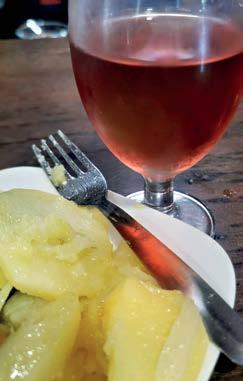
2 minute read
ON THE TAPAS TRAIL
The history and tradition of free drink accompaniments in Granada
AGIFT traditionally offered by bars in Granada province, tapa has a long history. Exactly how it was invented depends on the source you believe.

One legend says that, in the 13th century, King Alfonso X - ‘The Wise One’ - passed a decree forcing taverns to serve a small portion of food with wine to reduce drunkenness. Whether it worked is anyone’s guess, but Spain clearly has less of a public borracho problem then some other countries, including the UK.
In pre-19th-century Andalucia, the posadas, alberques and bodegas (roadside bars and hostals) were said to offer small samples of their dinner options, in the form of tapas. This was, apparently, because few proprietors could read or write, and could not create a menu board.
A salty lid to prevent flies
The most credible explanation is that the original tapas were ‘tops’ of bread or meat. Drinkers placed these over their wine, to prevent buzzing flies from falling into the glass when they weren’t sipping. Sometimes, the drink would be covered with local meat products, such as Serrano ham or chorizo. As these are salty, they made clients thirstier, which – in turn –increased drink sales. The meaty items expanded into other types of tapas, such
By Jo Chipchase
as carne en salsa or potato dishes.
Eventually, the tapas became as important as the alcohol. Today, the choice is endless, and the savvy drinker knows which bars, in their town, will serve the best tapas
In 2022, the mayor of Granada threatened to end free tapas but, to date, this hasn’t happened. It is one of the major attractions of the province.
Traditional and seasonal tapas
Tapas can be hot or cold. What’s served can depend on seasonal factors. For example, when baby broad beans are in season (soon), these are used in habas con jamón. In summer, you might receive pipirrana (a type of salad combining cold tomatoes, peppers, etc.), as well as potaje de hinojos when fennel is in season, and meatballs in almond sauce when those are abundant. Cold tapas, served all year round, frequently includes olives, nuts, cheese, chorizo, ham, Russian salad, tortilla, potato crisps, or – if you’re unlucky – crab sticks.
Hot dishes commonly include: patatas a lo pobre, potato chips (a lo rico), migas, meatballs, pork strips in creamy sauce, carne en salsa, lorganiza, cod, squid, prawns, paella rice, aubergine in honey, croquettes, sardines or boquerones and, sometimes, puchero or other stews. Callos is a stew with chickpeas that you then discov- er contains ‘some form of unidentifiable offal’, that might be pig’s feet. In old-school bars, visitors might still encounter cuts of meat that aren’t so noble. This has scared a few Brits, who aren’t accustomed to ‘strange’ animal parts. One reader, Frances Shaw, reported being served ‘garden snails in Almegijar – I couldn’t eat them’.

Expat, Richard Kayshan, said:
“At a hotel in La Alpujarra, I was literally served a pig’s trotter on a plate.” Another unfortunate Brit, Jane Ryder, was served ‘nostrils’, but in a different region of Spain.
“I once had Haribo sweeties on a bed of beef flavoured crisps in Pinos del Valle,” said Heather Sutherland. Although this is hardly haute cuisine, at least it’s not offal.
Contemporary tapas and chef’s specials
Some bars have adapted to serve tapas with a decidedly modern twist – whether it is a mini-tortilla or hamburger, a contemporary salad, or something of their own invention. Many times, you will sample the chef’s special, especially if they have over-provi- sioned for the lunch guests and have leftovers in the kitchen. Turning up at 3pm Sunday is a good way to get whatever delicious, hot food remains unserved in the pan. International restaurants might offer samples of their main menu. For example, a pizzeria might serve pizza slices, if you are lucky.
One venue in Alhendin, Granada - called Bar Santi - has served entirely fish tapas since the 1960s. This is great but can be a bit re




